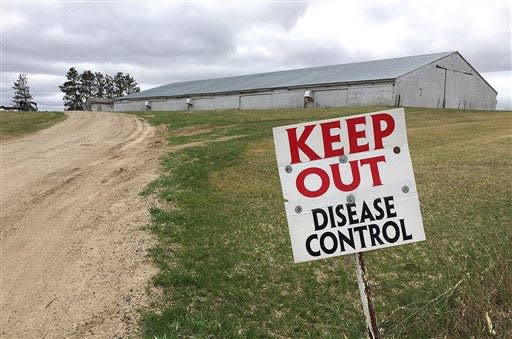'Extremely cruel' mass-killing method used in Oregon’s first commercial bird-flu outbreak

Nearly 800,000 chickens at two Willamette Valley poultry operations were killed in November in response to the first avian influenza outbreak to hit Oregon's commercial poultry operations.
A controversial method, which opponents call “extremely cruel,” was used to destroy most of those birds.
Ventilation shutdown plus heat, or VSD+, kills flocks by sealing off airflow in barns and pumping in heat until the animals die of heatstroke, which can take several hours.
Oregon is among five states that have used the method, according to the U.S. Department of Agriculture. Ventilation shutdown also has been used in Iowa, South Dakota, North Dakota and Utah.
Ventilation shutdown plus heat allowed as method of last resort
The American Veterinary Medical Association permits ventilation shutdown as a last resort when other mass-killing methods are not practical.
That was the case in Oregon, state veterinarian Ryan Scholz told the Statesman Journal.
On Nov. 17, the Oregon Department of Agriculture announced that avian influenza had been discovered in a Linn County broiler producer with 630,700 chickens and a Marion County broiler producer with 123,500 birds.
Avian influenza previously had been detected in wildlife and backyard flocks in Oregon, but that was the first time it hit the state’s commercial producers.
The highly pathogenic virus spreads quickly and may kill an entire poultry flock within 48 hours. The U.S. Department of Agriculture requires animals that could be infected to be killed within 24 to 48 hours.

Scholz said ODA, in conjunction with the USDA, authorized the facilities to use ventilation shutdown after the state quickly ran out of firefighting foam. Spraying birds with the foam to suffocate them is considered a more humane method of killing them.
Agriculture departments in Oregon and Washington jointly own an apparatus for applying the foam. ODA utilized that in the first two barns during the Linn and Marion county outbreak in November using a small amount of stockpiled foam concentrate, Scholz said.
But it wasn't enough, and the USDA told ODA it would not be able to supply more foam for five to seven days, he said.
Another authorized method of culling poultry is carbon dioxide poisoning, but that is impractical in large chicken houses, Scholz said.
“It’s great on paper, but the amount of CO2 that it takes to fill a barn, let alone multiple barns, and the amount of prep that goes into it and the cost of that … it just has not been a viable option for very many situations, just because you can’t get that much CO2,” he said.
“We would only use VSD+ in a situation where we have exhausted the other options that come before that in the line,” Scholz said.
In the end, he said, that was the only option.
“There’s always kind of a process of looking at what resources are available, what resources are an option and then coming up with a balance. The USDA guideline is that affected farms need to be depopulated within 48 hours of diagnosis, and so how do we do that given the resources we have in order to stop further spread of the disease,” he said.
In both of the Oregon commercial flocks where the virus was detected, the dead birds were composted, along with litter and other organic matter, in the barns. The process was overseen by a USDA expert and monitored daily to ensure the compost reached a sufficient temperature to kill the virus.
Catastrophic outbreak of avian flu in the US
According to the USDA, 47 states have been affected by the latest avian flu outbreak, which began in February 2022 and is the most catastrophic on record. So far, 81.4 million birds nationwide have been culled.
Animal depopulations are paid for with public dollars through a USDA program that compensates livestock farmers for their losses.
In Oregon, in addition to the two commercial operations, 35 backyard flocks have been affected.
Oregon Department of Agriculture officials said the avian flu outbreak does not pose a risk to the food supply.
The U.S. Centers for Disease Control considers avian influenza a low risk to human health.
Advocates urge ending use of ventilation shutdown method
Veterinarians and animal welfare advocates are urging an end to the ventilation shutdown method.
That includes more than 1,600 veterinarians with the group Veterinarians Against Ventilation Shutdown, who have urged the American Veterinary Medical Association to reclassify VSD+ as “not recommended.”
The Northwest Chicken Council, which represents chicken growers, does not have a position on the practice.
“I usually leave this to the veterinarians who know better than me about the most humane methods under emergency situations,” Bill Mattos, the council’s president, said in an email. “These depopulations are emergency situations with a bird flu that is more virulent than ever.”
Scholz said he can’t rule out using ventilation shutdown in future outbreaks in Oregon, but he’s hopeful it won’t come to that.
ODA has just purchased 240 gallons of foam concentrate — enough for the first 48 to 72 hours of an outbreak, he said. A typical chicken barn takes 30 to 50 gallons of foam concentrate.
And the state is developing relationships with local suppliers that can quickly supply foam.
The recent purchase cost $9,245, but that will eventually be reimbursed by USDA, which pays the cost of all supplies and equipment used in the avian influenza response.
Oregon’s 'success story' dealing with avian flu
Scholz noted Oregon was one of the last states in the country with commercial poultry production to have a commercial facility hit with the virus.
That’s despite the fact that many wild ducks and geese that migrate through the state carry the virus.
“The fact that our industry has made it this long, through multiple different successive outbreaks when we know the virus is here, we see it in backyard cases all the time, I think that does say a lot,” Scholz said.
“It’s unfortunate that we have had a couple of cases. But it’s also a success story too, that we’ve made it as long as we have with as few cases as we have.”
Tracy Loew covers the environment at the Statesman Journal. Send comments, questions and tips: tloew@statesmanjournal.com or 503-399-6779. Follow her on Twitter at @Tracy_Loew
This article originally appeared on Salem Statesman Journal: Oregon bird-flu outbreak: Controversial culling method used

